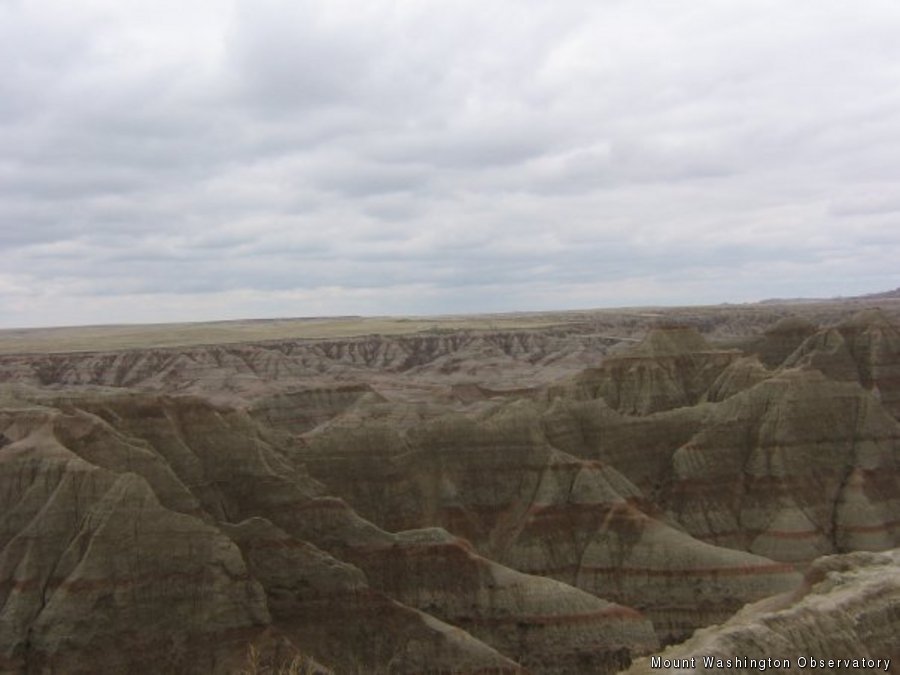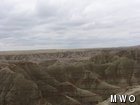SD
2009-05-03 05:20:52.000 – Mike Carmon, Observer and Meteorologist
The Badlands of South Dakota
If I may, I’m going to shift the focus of my comment from goings-on at the summit. In fact, I’m going to shift the focus about 2,000 miles away. On our last off week, Stacey, (now former) intern Jordan and I took a road trip out to the Black Hills of South Dakota. Why? Well, besides the obvious pleasures of spending a total of 72 hours in a car with a couple of people you live with for a week at a time already, one of the former ‘stranded’ Germans, Torben Stasch, is out at Wind Cave National Park doing some research/caving at Wind Cave and Jewel Cave. So, after a fairly busy shift change day two Wednesdays ago, the three of us hopped in a car and set out on a 2,000 mile journey across the country from the White Mountains to the Black Hills.
The drive was a long one, but it was well worth it. The setting out west is extremely different. Our visit began with a tour of Jewel Cave and Wind Cave. And imagine my excitement when I came to learn why these caves ‘breathe.’ It has to do with the equalization in pressure between the air inside and outside of the cave. It’s a lesson that’s taught from probably the first day of the first meteorology class I ever took-air flows from areas of higher to lower pressure. So if the air pressure inside the cave is higher than the pressure outside of the cave, the wind will blow out of the cave. Ahhh…weather is everywhere! (forgive my enthusiasm-I am a meteorologist)
Although wildlife is more apparent in the White Mountains than other locations in New Hampshire and the rest of the east, it is no where near as commonplace as in the Black Hills. One can hardly go from place to place without witnessing bison, deer, elk, wild turkeys, or a whole mess of prairie dogs. Or even some prehistoric beasts, as we observed (at least the remains of them) at Mammoth Site in Hot Springs, SD.
Any current/former observer/intern who has given a tour has probably been asked the following by a member at some time: ‘Where are the president’s faces?’ Unfortunately, many individuals mistakenly believe that the presidential range of the White Mountains is where you can find an engraving of four famous U.S. Presidents. That is not the case, which is the news we bear to the hypothetical tour member. In fact, the faces of George Washington, Thomas Jefferson, Theodore Roosevelt, and Abraham Lincoln can be found amidst the Black Hills at Mt. Rushmore. This was another stop of our tour of southwest South Dakota.
Being the scientists that we are, one of our favorite highlights on the trip was a drive through the Badlands. This is a prehistoric-looking area of southwestern South Dakota, where you can observe millions of years of soil history through the layering in the large towering spires. It was quite a sight to see, and definitely a must if one plans to venture out west.
Besides giving you a glimpse into some of our lives off the summit, there is another purpose to this comment. There is a link between the Black Hills and the White Mountains that I can pass along. As one travels westward from Mt. Washington, the first time the elevation surpasses the 6,288-foot mark of our summit is in the Black Hills. This is in fact one of the factors contributing to our regularly strong winds. Our prevailing winds are generally from the west, so for approximately 1800 miles (generally) upwind of Mt. Washington, there are no obstructions. So if you ever decide to follow suit and take a journey from the White Mountains of New Hampshire to the Black Hills of South Dakota, and it seems as though the drive is endless, just remember-this is the distance the wind travels, unimpeded, before it abruptly slams into the pitot-static anemometer fixed atop our tower. It may give you a new perspective (it certainly did for me).
Mike Carmon, Observer and Meteorologist
An Experience Worth 1,000 More
An Experience Worth 1,000 More By Mitchell Tsokatos Me and the summit sign once winter really got going. Taken 11/2/25. Unfortunately, my time on Mount Washington as an intern has come to
Supporter Spotlight: AJ Mastrangelo
Supporter Spotlight: AJ Mastrangelo By Wendy Almeida A young AJ on the summit with Rebecca Scholand. AJ Mastrangelo’s relationship with Mount Washington Observatory began long before his internship—or his current career as
Supporter Spotlight: Angelo Decrisantis
Supporter Spotlight: Angelo Decrisantis By Wendy Almeida For Angelo Decrisantis, Mount Washington has been a lifelong connection. It began in 1965, at age 15, on a family drive to the summit. “My first experience





